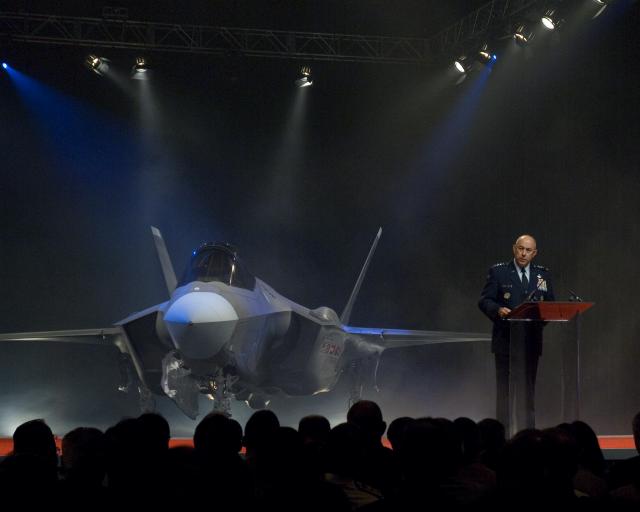The F-35 is a supersonic, multi-role, 5th generation stealth fighter. Three F-35 variants derived from a common design, developed together and using the same sustainment infrastructure worldwide, will replace at least 13 types of aircraft for 11 nations initially, making the Lightning II the most economical fighter program in history.
The program is on schedule to deliver aircraft to the U.S. military services beginning in 2010. The first test aircraft has completed 35 flights and has exceeded performance expectations. The inaugural flight of the first short takeoff/vertical landing F-35B is on schedule for mid-2008. All 19 test aircraft are in production flow or on the flightline, and assembly has begun on the first two production F-35s.

The F-35A is a conventional takeoff and landing variant designed for use with conventional runways. The F-35B is a short takeoff/vertical landing version that can operate from small carriers, austere bases and deploy near front-line combat zones. The F-35C will be the U.S. Navy's first stealth aircraft, and is designed to withstand the rigors of catapult launches and arrested recoveries aboard the Navy's large carriers. All F-35s are stealthy and supersonic, and incorporate the most powerful and comprehensive avionics suite ever flown on a fighter aircraft.
The U.S. Navy's version of the F-35 Lightning II is scheduled to make its first flight next year, but technicians have spent the last decade perfecting the aircraft's stealth design and materials to ensure they stand up to harsh carrier-deck and combat conditions with very little upkeep.
The F-35 achieves its Very Low Observable stealth performance through its fundamental design, its external shape and its manufacturing processes, which control tolerances to less than half the diameter of a human hair. Special coatings are added to further reduce radar signature.
The package is designed to remain stealthy in severe combat conditions and tests have validated that capability. After obtaining baseline radar cross section (RCS) measurements from a highly detailed, full-scale Signature Measurement Aircraft (SigMA), a team of Lockheed Martin and Northrop Grumman engineers intentionally inflicted extensive damage -- more than three dozen significant defects -- on the model. The damage represented the cumulative effect of more than 600 flight hours of military
aircraft operations. RCS measurements taken after the damage showed that the stealthy signature remained intact.
"The F-35C's stealth will bring a profound increase in capability to the Navy's fighter fleet. What it will not bring is increased maintenance," said Steve O'Bryan, a former carrier fighter pilot and director of F-35 Domestic Business Development for Lockheed Martin. "The Lightning II is a 5th generation fighter with supportable stealth that was designed into the aircraft from the very beginning. It will endure extreme abuse without degrading its stealth radar-signature performance."
A total of 2,581 F-35s are planned for the U.S. and U.K. services, with more than 600 additional aircraft expected to be integrated into the air forces of seven other partnering nations. Built in three variants, the F-35 will replace AV-8Bs and F/A-18s for the U.S. Marine Corps; A-10s and F-16s for the U.S. Air Force; F/A-18s for the U.S. Navy; Sea Harriers, GR.7s and GR.9s for the United Kingdom's Royal Air Force and Royal Navy; and other aircraft currently used by F-35 participant countries.




Comments